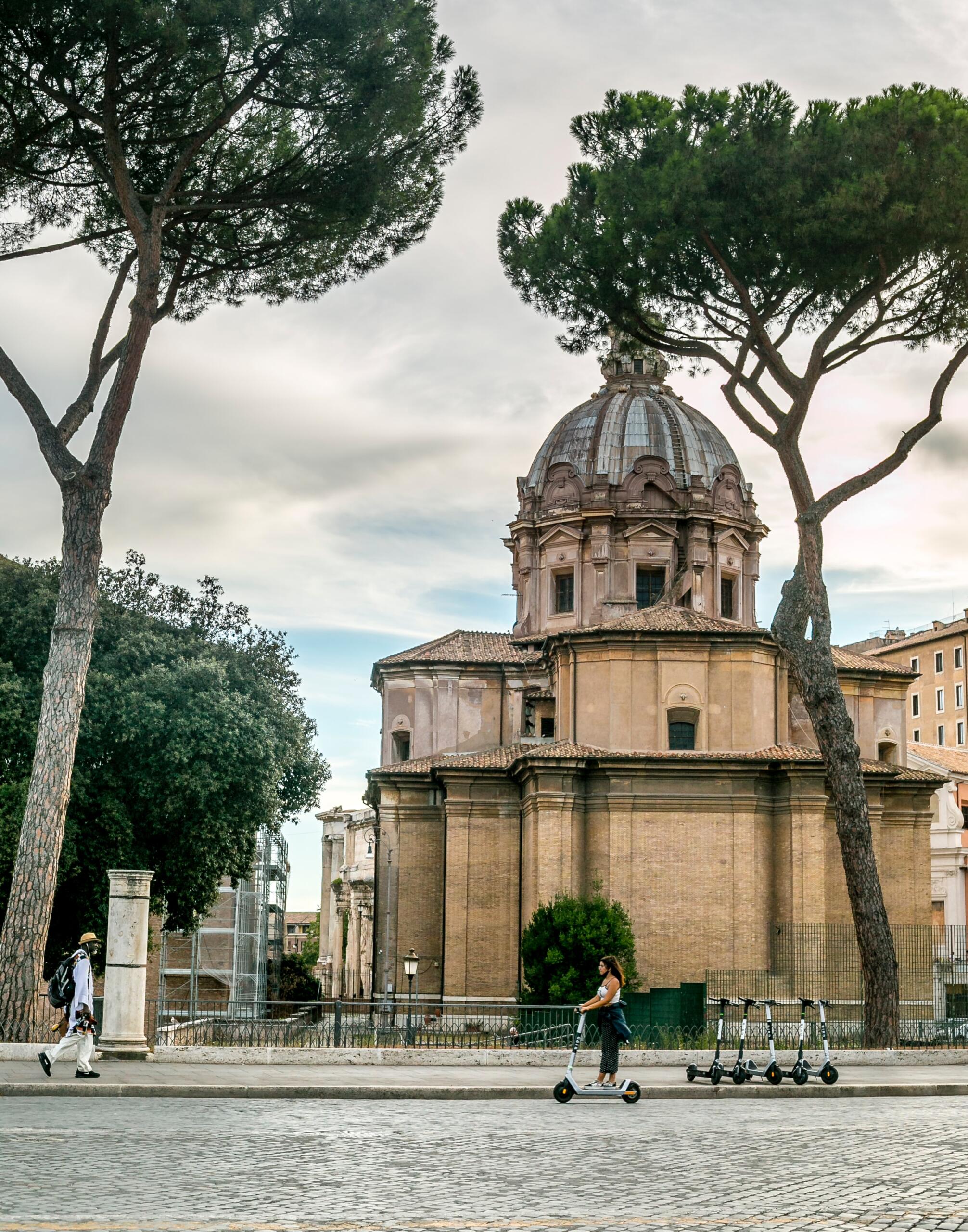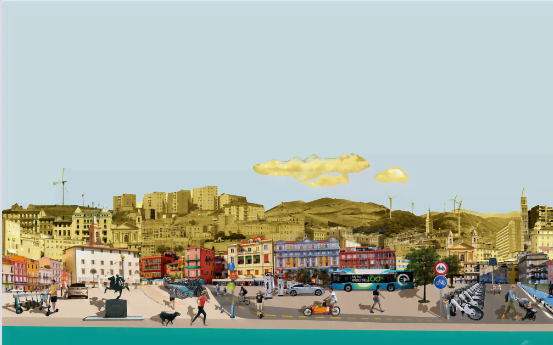A Mediterranean perspective
With an eye on the examples of leading cities in the area and the work of the Urban Transports Community, it is time to explore mobility in the Euro-Mediterranean.

Cobblestone street in Rome, Italy.
Credit: Mark Harpur / Unsplash
The Euro-Mediterranean is made up of EU and non-EU nations on the southern and northern coastlines of the Mediterranean. However, much more than a geopolitical entity, this area is home to a set of peculiar environmental, historical, and cultural traits that, in some instances, allow the inclusion of nations and territories that are not physically part of the region, such as Portugal.
The Euro-Mediterranean, characterised by relatively small but dense urban areas, is famed for its geographical and historical significance, yet its innovative mobility potential Is less explored than the one of other regions of the world, such as Northern Europe.
While examples like the Netherlands, Denmark or Sweden are well known, it is important to understand that what sometimes works in Northern Europe cannot necessarily be transferred to the south – a well-known truth for the Urban Transports Community (UTC).
The UTC is an Interreg MED initiative that promotes sustainable urban mobility planning in the Euro-Mediterranean region as an effective tool to reduce carbon emissions and improve the quality of life of the population and the environment. Led by MedCities and featuring POLIS among
its partners, the initiative covers a wide range of mobility-related topics and has tools and solutions for the key steps to achieve sustainable and zero-emission mobility in the Mediterranean – with a focus on soft mobility, tourism, electromobility, and climate change.
Soft mobility, strong results
Mediterranean countries have a higher motorisation rate compared to the EU average (560 cars/1,000 inhabitants). As a result, Mediterranean governments are increasingly committing to deploying ambitious policies to discourage car ownership while providing more sustainable soft mobility options and enhancing public spaces for their citizens.
Soft mobility (bicycles, e-bicycles, e-scooters, as well as walking) includes modes of transport that serve as sustainable options for relatively short trips. These modes largely rely on human physical activity or alternative power – electric and solar, for example; however they also require appropriate infrastructure to encourage their use. This is particularly important in the Euro-Mediterranean area, where appropriateness translates not only to attractiveness but also to safety.
From Mdina (MT) to Rome (IT) or Lisbon (PT), most cities in the Med-area have historical centres that cannot be simply rebuilt or adapted to active modes. Indeed, narrow cobblestone streets do not always match well with safely or comfortably riding bikes, while also complicating the job of e-scooter collecting trucks.
Moreover, looking at the examples of Haifa (IL) or Rimini (IT), warm Mediterranean summers call for a climate-sensitive approach to designing urban mobility infrastructure. We see this clearly with bike lanes, where roadside installations, such as water fountains, rest areas, and refreshment stations, as well as vegetation along and around bike tracks, not only have a significant visual and social impact, but also provide basic needs and shade, reduce glare, and help to lower air temperatures – issues that are often absent from conversations amongst Northern European countries!
They see them rollin’, but they lovin’
When it comes to improving cycling networks, it is also relevant to mention the case of the Metropolitan Area of Barcelona (ES). Here, following a 6-month consultation, a 550 km metropolitan cycling network connecting 36 previously separated municipalities is now in the works and scheduled for completion by 2025. Similarly, yet on a smaller scale, Durrës (AL) successfully integrated its existing cycling.

The app Zadar Bike Magic.
Credit: Zadar Bike Magic
Guidance for improving user experience and effective monitoring of their use is critical. For example, the city of Misano (IT) marked its cycling network with visible signposts, indicating not only relevant directions (to the waterfront, the centre, the schools, etc), but also registering the number of transiting cyclists, thus providing information on the quantifiable real use of the bike lanes.
The case of Zadar (HR) and Igoumenitsa (EL) finally show that, aside from interventions and guidance, cycling success requires determined political will. Here, when decision-makers took bold steps, sustainability accelerated; from the collection of mobility and air quality data, cycle road mapping, and upgrading an existing smartphone app (Zadar Bike Magic), to a more traditional take on refurbishing marked by the revamp of a misused bike-sharing system.
It's electrifying, really
The Euro-Mediterranean area is increasingly adopting the use of e-vehicles and micromobility solutions due to the greater accessibility to electric charging infrastructure and the stronger public-private partnerships between cities and electromobility providers – though still behind the rates seen in Central and Northern European countries.

Igoumenitsa bike-share during European Mobility Week 2017.
Credit: Eltis - Eurocities - EUROPEANMOBILITYWEEK
Electric mopeds, for example, have gained traction in many tourist destinations characterised by mild weather and a prominent motorcycle culture – Genoa (IT), Nice (FR), Barcelona and Valencia (ES), to name a few.
Many Mediterranean cities have also experimented with electric shared micromobility by launching innovative pilot projects. We see this in the case of the municipality of Rethymno (EL), which is currently operating 10 micromobility charging stations for e-bikes and e-scooters as part of the project ‘Electric mobility solutions for tourists and residents’, showing the ambition to turn this trend into a long-lasting offer.
Similarly, e-bus deployment plans in the Mediterranean are accelerating, with Marseille (FR), the first city to launch a 100% electric bus line, seeking to convert around 50 buses per year – electrifying its entire fleet by 2035, Mersin (TR) securing extensive funding for a 100 strong e-bus fleet to help save 20,468 tonnes of CO2, and Alexandria (EG), Tunis (TN) and Marrakesh (MA) showing a considerable and growing employment of clean public transport fleets.
Hot, Mediterranean summer with a side of tourism and mobility
Climate and tourism are at the heart of mobility strategies across the Euro-Mediterranean. Indeed, the temperate Mediterranean climate has driven the growth of tourism, yet also starkly exposed the urgency for transitioning to a mobility which can cut carbon emissions to survive the mounting temperatures we are seeing as our climate changes before our eyes.

Tunis has rolled out its e-buses in 2018.
Credit: Marhba News
Both the ‘First Mediterranean Assessment Report’ and the IPCC Sixth Assessment Report ‘Climate Change 2022: Impacts, Adaptation and Vulnerability’ find that the Mediterranean is warming up 20% faster than other regions in the world. Surface temperature is now already 1.5°C higher than during pre-industrial times and, in the worst-case scenario, it is expected to rise until 2100 by an additional 3.8 to 6.5°C.
Global warming will likely be accompanied by a reduction in summer precipitation of about 10-15% in Southern France, North-western Spain, and the Balkans, and up to 30% in Turkey, with cases of extreme weather events already becoming more frequent and increasingly affecting people’s health, lives, property, infrastructures, energy, and – unsurprisingly – transport systems and tourism.
During heatwaves power consumption increases due to air conditioning use, causing frequent power outages. Heat, on the other hand, reduces the efficiency and durability of solar panels, cables and electric stations – a risk for e-charging infrastructures.
Moreover, extreme heat has also the potential to reduce and shift tourism, while exacerbating the use of unsustainable modes – this is more people opting for a car with A/C on full blast, for example.
A copy-and-paste transport solution is not necessarily the optimum approach for Euro-Med countries: POLIS members like Barcelona, Reggio Emilia, Puglia, and Kadikoy have presented their unique approaches to cycling, multimodality, parking, and infrastructure at POLIS’ Active Travel, Small and Medium Sized Cities Platform and Regions Working Group meetings.
- Isobel Duxfield, Membership & Communications Manager, Regions Working Group & SMC Platform Coordinator at POLIS Network
It's getting hot in here
In 2019, just before the pandemic, Mediterranean tourism accounted for up to 15% of regional GDP, with 75% growth since 1995, expected to reach 626 million international tourist arrivals by 2025 according to the UN World Tourism Organization (WTO). Badly hit by the COVID-19 outbreak, the sector is now at a crossroads, and it can either shift toward greener tourism patterns, or it can revert to its previous trend of uncontrolled mass tourism.
Ambitious, green, and inclusive recovery roadmaps at the local, national, and regional levels are thus critical to ensuring a bright future for Mediterranean tourism and contributing to a thriving, inclusive, and sustainable region. Mobility needs to be included in these roadmaps. Integrating mobility, tourism, and climate change agendas is indeed the only way forward for Mediterranean countries; they are intertwined elements that shape the region’s identity.
There are major gains to be made. Developing a sustainable, low-carbon mobility model for locals and visitors, fostering the competitiveness of the Euro-Mediterranean area on the international stage, tackling externalities of unsustainable mobility practices, and enhancing the quality of life and the experience of both the resident population and visitors without jeopardising the environment are the golden rules of survival.
It is the Catch-22 for 2022; there will not be any e-bikes or pedestrians around Mediterranean cities if there are no local riders or tourists, and there will not be any local riders or tourists without the opportunity for fresh, clean air.

The Mediterranean is at heightened risk from climate change .
Credit: UNEP / MAP and Plan Bleu, 2020
Click here to read the article in its original format.
About the authors
Alessia Giorgiutti is Communications Coordinator at POLIS. She coordinates POLIS' corporate communications and magazine and is involved in several EU-funded projects - namely, e-smartec and ReVeAL, iDREAMS and Urban Transports Community. She also supports other POLIS projects in tasks related to content production and communication. Passionate about inclusive mobility and transport justice, she focuses on making mobility issues 'pop' and relevant for a wider audience.
